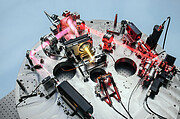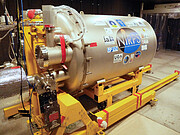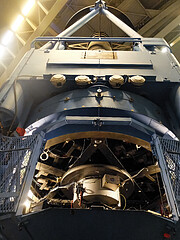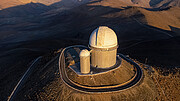Announcement
A new planet hunter awakens: NIRPS instrument sees first light
27 June 2022
The Near InfraRed Planet Searcher (NIRPS) instrument, mounted on ESO’s 3.6-m telescope at the La Silla Observatory in Chile, has successfully performed its first observations. Its mission is to search for new exoplanets around the Milky Way’s coolest stars.
“NIRPS has been a long time in the making, and I’m thrilled with how this mission has come together!” says René Doyon, Director of the Institute for Research on Exoplanets, Université de Montréal, and co-Principal Investigator of NIRPS. “This incredible infrared instrument will help us find the closest habitable worlds to our own Solar System.”
The instrument will focus its search on rocky worlds, which are key targets for understanding how planets form and evolve, and are the most likely planets where life may develop. NIRPS will search for these rocky exoplanets around small, cool red dwarf stars — the most common type of stars in our Milky Way galaxy, which have masses from about two to ten times smaller than our Sun.
NIRPS will search for exoplanets using the radial velocity method. As a planet orbits a star, its gravitational attraction causes the star to “wobble” slightly, causing its light to be redshifted or blueshifted as it moves away from or towards Earth. By measuring the subtle changes in the light from the star, NIRPS will help astronomers measure the mass of the planet as well as other properties.
NIRPS will search for these spectral wobbles using near-infrared light as this is the main range of wavelengths emitted by such small, cool stars. It joins the High Accuracy Radial velocity Planet Searcher (HARPS) in the hunt for new rocky worlds. HARPS, which has been installed on ESO’s 3.6-m telescope at the La Silla Observatory in Chile since 2003, also uses the radial velocity method, but operates using visible light. Using both instruments simultaneously will provide a more comprehensive analysis of these rocky worlds.
“NIRPS optimally complements HARPS by providing near-infrared wavelength coverage,” explains Céline Peroux, ESO Project Scientist for NIRPS. “This is ideal to observe Earth-like exoplanets around redder stars.”
Another key difference between the two instruments is that NIRPS will rely on a powerful adaptive optics system. Adaptive optics is a technique that corrects for the effects of atmospheric turbulence, which cause stars to twinkle. By using it, NIRPS will more than double its efficiency in both finding and studying exoplanets.
“NIRPS joins a very small number of high-performance near-infrared spectrographs and is expected to be a key player for observations in synergy with space missions like the James Webb Space Telescope and ground-based observatories,” adds François Bouchy, from the University of Geneva, Switzerland, and co-Principal Investigator of NIRPS.
Discoveries made with NIRPS and HARPS will be followed up by some of the most powerful observatories in the world, such as ESO’s Very Large Telescope and the upcoming Extremely Large Telescope in Chile (for which similar instruments are in development). By working together with both space- and ground-based observatories, NIRPS will be able to gather clues on an exoplanet’s composition and even look for signs of life in its atmosphere.
NIRPS was built by an international collaboration led by the Institute for Research on Exoplanets team at the Université de Montréal in Canada and the Observatoire Astronomique de l’Université de Genève in Switzerland.
More Information
The institutes involved in the NIRPS consortium are the Université de Montréal, Canada; the Université de Genève, Observatoire Astronomique, Switzerland; Instituto de Astrofísica e Ciências do Espaço, University of Porto & University of Lisbon, Portugal; Instituto de Astrofísica de Canarias, Spain; Université de Grenoble, France; and the Universidade Federal do Rio Grande do Norte, Brazil.
Contacts
François Bouchy
Observatoire Astronomique de l’Université de Genève
Tel: +41 22 37 92 460
Email: francois.bouchy@unige.ch
René Doyon
Institute for Research on Exoplanets — Université de Montréal
Tel: +1 514 343 6111 x3204
Email: rene.doyon@umontreal.ca
Celine Peroux
ESO Project Scientist for NIRPS
Phone: +49 89 3200 6346
Email: cperoux@eso.org
Norbert Hubin
ESO Project Manager & Engineer for NIRPS
Phone: +49 89 3200 6517
Email: nhubin@eso.org
Bárbara Ferreira
ESO Media Manager
Garching bei München, Germany
Tel: +49 89 3200 6670
Email: press@eso.org
About the Announcement
| Id: | ann22009 |
Our use of Cookies
We use cookies that are essential for accessing our websites and using our services. We also use cookies to analyse, measure and improve our websites’ performance, to enable content sharing via social media and to display media content hosted on third-party platforms.
ESO Cookies Policy
The European Organisation for Astronomical Research in the Southern Hemisphere (ESO) is the pre-eminent intergovernmental science and technology organisation in astronomy. It carries out an ambitious programme focused on the design, construction and operation of powerful ground-based observing facilities for astronomy.
This Cookies Policy is intended to provide clarity by outlining the cookies used on the ESO public websites, their functions, the options you have for controlling them, and the ways you can contact us for additional details.
What are cookies?
Cookies are small pieces of data stored on your device by websites you visit. They serve various purposes, such as remembering login credentials and preferences and enhance your browsing experience.
Categories of cookies we use
Essential cookies (always active): These cookies are strictly necessary for the proper functioning of our website. Without these cookies, the website cannot operate correctly, and certain services, such as logging in or accessing secure areas, may not be available; because they are essential for the website’s operation, they cannot be disabled.
Functional Cookies: These cookies enhance your browsing experience by enabling additional features and personalization, such as remembering your preferences and settings. While not strictly necessary for the website to function, they improve usability and convenience; these cookies are only placed if you provide your consent.
Analytics cookies: These cookies collect information about how visitors interact with our website, such as which pages are visited most often and how users navigate the site. This data helps us improve website performance, optimize content, and enhance the user experience; these cookies are only placed if you provide your consent. We use the following analytics cookies.
Matomo Cookies:
This website uses Matomo (formerly Piwik), an open source software which enables the statistical analysis of website visits. Matomo uses cookies (text files) which are saved on your computer and which allow us to analyze how you use our website. The website user information generated by the cookies will only be saved on the servers of our IT Department. We use this information to analyze www.eso.org visits and to prepare reports on website activities. These data will not be disclosed to third parties.
On behalf of ESO, Matomo will use this information for the purpose of evaluating your use of the website, compiling reports on website activity and providing other services relating to website activity and internet usage.
Matomo cookies settings:
Additional Third-party cookies on ESO websites: some of our pages display content from external providers, e.g. YouTube.
Such third-party services are outside of ESO control and may, at any time, change their terms of service, use of cookies, etc.
YouTube: Some videos on the ESO website are embedded from ESO’s official YouTube channel. We have enabled YouTube’s privacy-enhanced mode, meaning that no cookies are set unless the user actively clicks on the video to play it. Additionally, in this mode, YouTube does not store any personally identifiable cookie data for embedded video playbacks. For more details, please refer to YouTube’s embedding videos information page.
Cookies can also be classified based on the following elements.
Regarding the domain, there are:
- First-party cookies, set by the website you are currently visiting. They are stored by the same domain that you are browsing and are used to enhance your experience on that site;
- Third-party cookies, set by a domain other than the one you are currently visiting.
As for their duration, cookies can be:
- Browser-session cookies, which are deleted when the user closes the browser;
- Stored cookies, which stay on the user's device for a predetermined period of time.
How to manage cookies
Cookie settings: You can modify your cookie choices for the ESO webpages at any time by clicking on the link Cookie settings at the bottom of any page.
In your browser: If you wish to delete cookies or instruct your browser to delete or block cookies by default, please visit the help pages of your browser:
Please be aware that if you delete or decline cookies, certain functionalities of our website may be not be available and your browsing experience may be affected.
You can set most browsers to prevent any cookies being placed on your device, but you may then have to manually adjust some preferences every time you visit a site/page. And some services and functionalities may not work properly at all (e.g. profile logging-in, shop check out).
Updates to the ESO Cookies Policy
The ESO Cookies Policy may be subject to future updates, which will be made available on this page.
Additional information
For any queries related to cookies, please contact: pdprATesoDOTorg.
As ESO public webpages are managed by our Department of Communication, your questions will be dealt with the support of the said Department.





